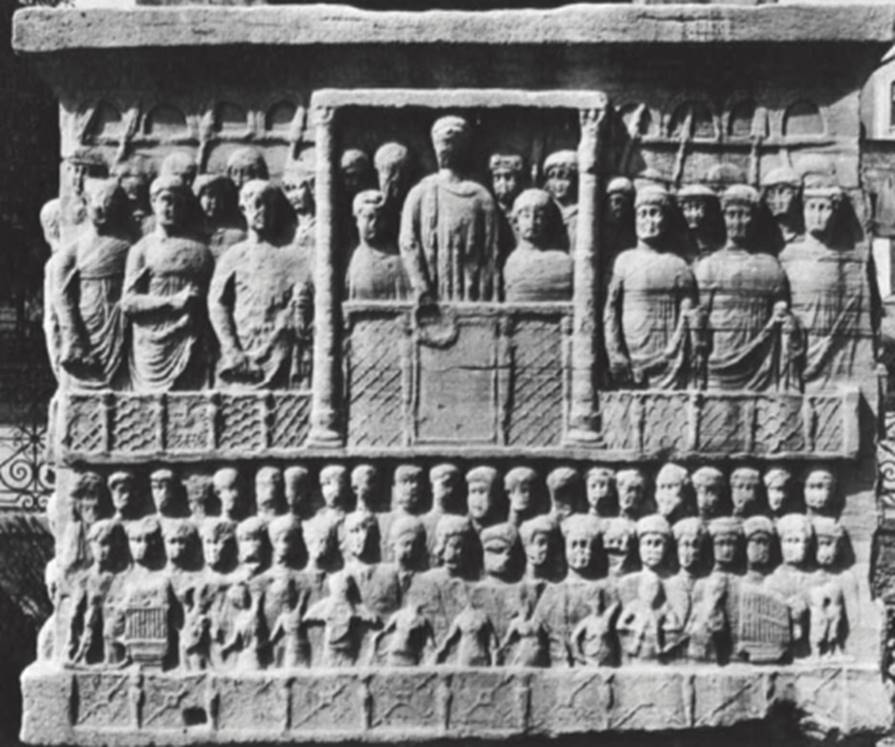Relief with prize presentation scene from the Theodosian obelisk. Constantinople, 390. Marble
As a feature of his intensive monumental development of Constantinople, the emperor Theodosius I erected an obelisk on the spina of the hippodrome at Constantinople in 390 upon a base decorated with relief sculpture, possibly completed only under Arcadius in 395-396. This base was divided into two parts; the lower level showed on opposite sides the erection of the obelisk itself and a chariot race in the circus, while Greek and Latin inscriptions covered the other two sides.
The upper level of the base consists of four large, formally composed relief panels representing; northeast, Theodosius at court (Bruns, 1935, fig. 44); northwest, Theodosius receiving an embassy of barbarians (Bruns, 1935, fig. 37); southwest, Theodosius in state (Bruns, 1935, fig. 62); and southeast, the scene shown here— Theodosius at the hippodrome. The north panels have been attributed to a single artist, designated as "B," the south panels to another, known as "A." All four compositions are symmetrical, abstract, and hieratic, stressing the exaltation of Theodosius and members of his dynasty, with sculptor "B" slightly more insistent.

These schemata reflect the official format developed for imperial representation much earlier in the fourth century, as exemplified by the oratio and largitio registers in the Arch of Constantine (no. 58), and anticipate the mosaics of Justinian and his entourage in S. Vitale in Ravenna (nos. 65, 66). In this capacity the four principal reliefs of the Theodosian obelisk function as a monumental, figural counterpart to the late Roman panegyrics, delivered before the emperor at state occasions in testimony to his glorious majesty.
This panel is divided into two zones, which correspond to distinctions of office and status. Below, the spectators at the chariot races have been depicted in two rows of frontal heads, their bodies hardly shown, while beneath them musicians and dancers entertain the crowd. The upper part of the relief represents the pulvinar or imperial box in the center with flanking wings filled with officials and a guard of soldiers (cf. no. 83). Some of these officials are in consular dress and hold mappae, by which they indicate the start of the race, in their right hands. The central box with its elaborate balustrade and aedicula reveals the frontal, dominating image of Theodosius, who holds out the victory wreath in his right hand, prepared to bestow the prize on the victor in the chariot race. Since the victor is not shown and the emperor looks directly out of the panel, there is a strong implication that all victors are dependent on Theodosius as the giver of victory and of its rewards. Guards and officials attend the emperor, although the two small figures who flank his majestic person are probably to be identified as his sons, Arcadius and Honorius. This dynastic imagery follows well-established precedents (no. 63) and was employed by Theodosius as well in the famous Missorium (no. 64). Unfortunately, the condition of the relief surface is such that identifications are difficult, especially given the idealizing tendencies of the period, but it is likely that the high officials seen standing front in the wings were individually portrayed.
These panels are important in the history of late Roman-early Byzantine art because they represent the continued evolution of an ever more rigid state imagery as a means of eliciting a reverential response from the viewer. Bibliography: Bruns, 1935, pp. 61-68, figs. 77-85; Budde, 1957, p. 5; von Sydow, 1969, pp. 81-82, 124-126; Bianchi Bandinelli, 1971, pp. 332-337; Kahler, 1975.
Date added: 2025-07-10; views: 179;
